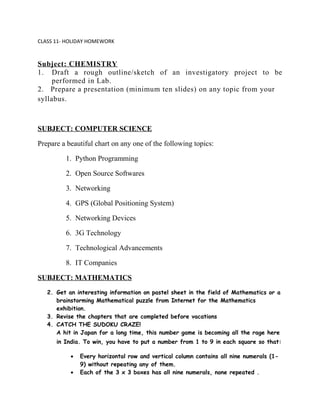This document provides homework assignments for various subjects for Class 11 students over their holiday break. Some of the key assignments include:
- For Chemistry: Drafting an outline for an investigatory lab project and preparing a 10 slide presentation on a syllabus topic.
- For Computer Science: Creating a chart on topics like programming, networking, GPS, etc.
- For Mathematics: Getting information on pastel sheets, solving puzzles, revising chapters, learning Sudoku, and proving properties of exponents and numbers.
- For English: Reading a novel and completing comprehension questions, character sketches and analysis.
- For Physics: Creating a working model on topics like energy, forces, oscillations, and completing problems







